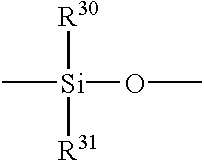Method of making siloxane-based polymides
a technology of siloxane and polyamide, which is applied in the field of making siloxane-based polyamides, can solve the problems of difficult to produce in commercial quantities, prohibitive cost of products,
- Summary
- Abstract
- Description
- Claims
- Application Information
AI Technical Summary
Benefits of technology
Problems solved by technology
Method used
Image
Examples
example 1
30 DP Polymer
A 500 ml three neck flask equipped with a thermometer, electrical stirrer, nitrogen sweep, and a condenser, was charged with 50.12 g of undecylenic acid, and 22.58 g of a 70% hexamethylene diamine mixture in water. The flask was immediately heated to 225 degrees C. and kept at this temperature for 2 hours. After 2 hours, a vacuum was applied to the system for 2 hours to remove any unreacted materials. Upon completion of vacuum stripping, the flask was reweighed to obtain the product weight. The temperature was increased to 120 degrees C., and 65 g of toluene, complex of platinous chloride and divinyl tetramethyl disiloxane, were added to the flask. The temperature was increased to 185 degrees C., and 279.2 g of a 30 DP dimethylhydrogen endblocked polydimethylsiloxane was added to the flask over a 30 minute period. After complete addition, a dean stark trap was used to replace the addition funnel on the flask, and the toluene was removed from the flask. After removal of ...
example 2
20 DP Polymer
A 500 ml three neck flask equipped with a thermometer, electrical stirrer, nitrogen sweep, and a condenser, was charged with 55.0 g of undecylenic acid, and 24.77 g of a 70% hexamethylene diamine mixture in water. The flask was immediately heated to 225 degrees C., and kept at this temperature for 2 hours. After 2 hours, a vacuum was applied to the system for 2 hour to remove any unreacted materials. Upon completion of vacuum stripping, the flask was reweighed to obtain the product weight. The temperature controller was increased to 120 degrees C., and 65 g of toluene, and 0.5 g of a solution containing platinum in the form of a complex of platinous chloride and divinyl tetramethyl disiloxane, were added to the flask. The temperature was then increased to 185 degrees C., and 222.0 g of a 20 DP dimethylhydrogen endblocked polydimethylsiloxane was added to the flask over a 30 minute period. After complete addition, a dean stark trap was used to replace the addition funnel...
example 3
15 DP Polymer
A 500 ml three neck flask equipped with a thermometer, electrical stirrer, nitrogen sweep, and a condenser, was charged with 57.75 g of undecylenic acid, and 24.77 g of a 70% hexamethylene diamine mixture in water. The flask was immediately heated to 225 degrees C., and kept at this temperature for 2 hours. After 2 hours, a vacuum was applied to the system for 2 hours to remove any unreacted materials. Upon completion of vacuum stripping, the flask was reweighed to obtain the product weight. The temperature was increased to 120 degrees C., and 65 g of toluene, and 0.5 g of a solution containing platinum in the form of a complex of platinous chloride and divinyl tetramethyl disiloxane were added to the flask. The temperature was then increased to 185 degrees C., and 168.72 g of a 15 DP dimethylhydrogen endblocked polydimethylsiloxane was added to the flask over a 30 minute period. After complete addition, a dean stark trap was used to replace the addition funnel on the f...
PUM
| Property | Measurement | Unit |
|---|---|---|
| Temperature | aaaaa | aaaaa |
| Angle | aaaaa | aaaaa |
| Mass | aaaaa | aaaaa |
Abstract
Description
Claims
Application Information
 Login to View More
Login to View More - R&D
- Intellectual Property
- Life Sciences
- Materials
- Tech Scout
- Unparalleled Data Quality
- Higher Quality Content
- 60% Fewer Hallucinations
Browse by: Latest US Patents, China's latest patents, Technical Efficacy Thesaurus, Application Domain, Technology Topic, Popular Technical Reports.
© 2025 PatSnap. All rights reserved.Legal|Privacy policy|Modern Slavery Act Transparency Statement|Sitemap|About US| Contact US: help@patsnap.com



